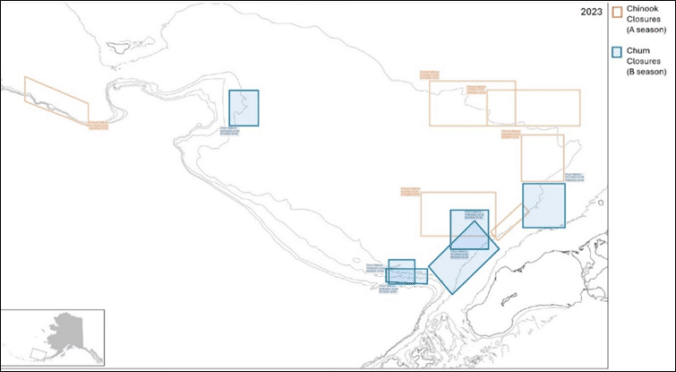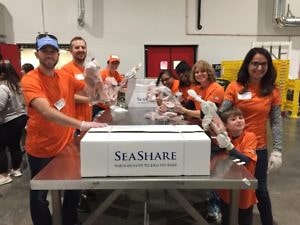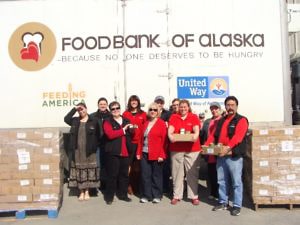Pacific Salmon Bycatch Overview
Bycatch is defined in the Magnuson-Stevens Fishery Conservation and Management Act (MSA) as fish that are harvested in a fishery but which are not sold or kept for personal use. This includes the portion of the catch that is discarded back into the sea and unobserved mortality due to a direct encounter with fishing gear that does not result in the capture of that species by a fisherman. Discards include species that must be returned to the sea by law (regulatory discards), and fish that are discarded at the discretion of the fisherman because they are not economically worthwhile to keep (economic discards).
Although fishermen try to catch only fish that can be sold, fishing gear is not 100% selective, and some unintended fish and other organisms are caught incidentally in the course of fishing operations. These non-target organisms are considered bycatch. The Council works to balance the priorities of all of the national standards in the MSA, one of which states that conservation and management measures shall, to the extent practicable, minimize bycatch, and to the extent bycatch cannot be avoided, minimize the mortality of such bycatch.
Salmon are considered prohibited species catch (PSC) and cannot be retained by fishermen for sale. Salmon are incidentally caught in the Bering Sea and Aleutian Islands (BSAI) offshore trawl fisheries, primarily the pollock pelagic trawl fishery. Nearly all salmon taken as bycatch are Chinook salmon and chum salmon.
Bering Sea Salmon Bycatch Amounts and Origin
The incidental catch of salmon in groundfish fisheries is closely monitored to ensure that all salmon are counted, and representative samples are taken for genetic identification of the area of origin. Every salmon caught as bycatch in the Bering Sea pollock fishery is counted and identified by a certified observer. An observer or Electronic Monitoring system for compliance is deployed on every catcher vessel, and observers at shoreside processors monitory every delivery from these vessels in the Bering Sea pollock fishery. All catcher processors and motherships always have two observers onboard, and every haul is monitored. A history of Chinook salmon and chum salmon bycatch in the Bering Sea pollock fishery is shown in the following figures.
Collection of genetic information from salmon taken as bycatch also provides information on what river systems the salmon originated. For example, in 2023, 47.2% of the Chinook salmon bycatch was estimated to have originated from coastal western Alaska with less than 1% attributed to the middle/upper Yukon River systems (0.00% and 0.03%, respectively).
The 2023 chum salmon samples indicate that most salmon bycatch is from Asia (68.8% and primarily hatchery fish), with approximately 2.3% from the middle and upper Yukon River and 8.3% from coastal western AK river systems. Annual monitoring of the bycatch indicates that the composition of the bycatch varies somewhat from year to year. Chinook salmon bycatch in the Gulf of Alaska is almost entirely composed of fish from Southeast Alaska, British Columbia and the Pacific Northwest.
Because the salmon caught as bycatch are also measured and scale samples are taken for aging, scientists can estimate the ‘adult equivalents’ of the bycatch, which is an estimate of how many of the bycaught salmon may have returned as adults to spawn. By comparing the adult equivalent numbers with the run size of fish returning to various river systems, scientists can then estimate the impacts of salmon bycatch on the runs in the different regions. As estimated in 2012, in all but the highest years (e.g., 2007), Chinook salmon bycatch occurring in the Bering Sea represented less than 3% of total western Alaska Chinook salmon returns and chum salmon bycatch represented less than 1% of total western Alaska chum salmon returns.

Bering Sea Salmon Bycatch Management Measures
Since the mid-1990s, the Council and NMFS have developed and implemented a series of measures to minimize the incidental catch of Chinook and chum salmon in the groundfish trawl fisheries. These measures have primarily focused on closure areas and PSC limits.

Hotspot Closure Areas
Since the early 2000s, the pollock fleet has cooperatively worked to communicate and share data to identify areas on the pollock fishing grounds with high salmon bycatch encounters and move the fleet to new areas to target pollock. These dynamic time and area closures are referred to as “rolling hotspots,” which are identified based on near real-time catch and bycatch data. The adjacent figure shows the Chinook salmon and chum salmon hotspot closures for the inshore catcher vessel sector in 2023.

Chinook Salmon Bycatch Hard Caps (Amendment 91)
Since 2011, the Bering Sea pollock fishery has operated under two hard caps (or PSC limits) for Chinook salmon—60,000 and 47,591 Chinook salmon. Under Amendment 91 which implemented the Chinook hard caps, the pollock fleet operates under a total limit of 60,000 Chinook salmon and vessels can voluntarily participate in Incentive Plan Agreements (IPAs). IPAs were implemented alongside the overall Chinook salmon hard caps to incentivize vessel operators to avoid Chinook salmon at all levels of abundance on the pollock fishing grounds. All entities have participated in an approved IPA since 2010, and IPA representatives provide annual reports to the Council that evaluate the efficacy of the incentive measures in place under the IPA.
While the overall hard cap is 60,000 Chinook salmon, and it is divided among the fishing sectors, the fleet effectively operates under the lower limit of 47,591 Chinook salmon. The lower cap of 47,591 Chinook salmon is divided among the fishing sectors, and a sector cannot exceed its portion of that threshold amount more than 2 times in any 7 consecutive years in order to continue to receive an apportionment of the 60,000 Chinook salmon hard cap. This program provides the pollock fishery participants with incentives to limit Chinook salmon bycatch to the performance standard in every year, but provides the fleet with some flexibility should it encounter unanticipated changes in the fishery due to weather, operating conditions, or the status of target or bycatch species stocks.
Three-River Index for Chinook Salmon (Amendment 110)
After implementing the Chinook salmon hard caps, the Council considered different ways of indexing the Chinook salmon hard caps to western Alaska Chinook salmon abundance. This action was taken in in response to multiple years of historically low Chinook salmon abundance, which resulted in significant restrictions for subsistence users in western Alaska and failure to achieve conservation objectives. While the impact of Chinook salmon bycatch on western Alaska stocks had been low under Amendment 91, and fishing sectors had not exceeded the performance standard, the Council wanted to further minimize Chinook salmon bycatch at low levels of salmon abundance.
The Three-River index was developed to determine western Alaska Chinook salmon abundance, and it is based on the sum of the run sizes of the Kuskokwim, Unalakleet, and Upper Yukon River systems. If the abundance of Chinook salmon returning to these three systems is less than 250,000 fish, the overall hard cap drops to 45,000 Chinook salmon and the lower limit to 33,318 Chinook salmon. In years when Chinook salmon abundance is not determined to be low (i.e., greater than 250,000 fish), the fleet is managed under the 47,591 and 60,000 Chinook salmon hard caps. A comparison of the different hard caps is shown in the adjacent figure.

In addition to the Three-River Index, Amendment 110 also incorporated chum salmon bycatch measures into the existing IPAs and implemented additional regulatory requirements for the IPAs to provide incentives to the pollock fleet to minimize Chinook salmon and chum salmon bycatch to the extent practicable. Some of these IPA requirements include incentives for the operator of each vessel to avoid Chinook salmon and chum salmon bycatch under any condition of Pollock and Chinook salmon abundance in all years; rewards for avoiding Chinook salmon, penalties for failure to avoid Chinook salmon at the vessel level or both; and an explanation of how the incentive measures in the IPA are expected to promote reductions in a vessel’s Chinook salmon and chum salmon bycatch rates relative to what might have occurred in the absence of the incentive program rewards and penalties.
Salmon Excluder Devices
For several years, the Bering Sea pollock industry has been working on developing a Chinook salmon excluder device for trawl gear, which allows salmon to escape from the trawl net underwater while retaining pollock. The success of such devices relies on the different swimming behaviors of pollock and Chinook salmon. Through experimental fishery permits authorized by the Council and NOAA Fisheries, various iterations have been tested, and their voluntary use by pollock skippers is increasing. The pollock fishery operating in the Gulf of Alaska has worked to adapt the excluder device for use in the smaller Gulf fleet.
Gulf of Alaska Salmon Bycatch Management Program
The Gulf of Alaska groundfish fisheries are composed of a pollock and non-pollock component. The Central Gulf of Alaska Rockfish Program operates under a cooperative and catch share program while other groundfish trawl fisheries in the Gulf operate under a limited access program but catch shares are not assigned. The Gulf of Alaska Pollock fishery operates under area-specific hard caps—18,316 Chinook salmon in the Central Gulf of Alaska and 6,683 Chinook salmon in the Western Gulf of Alaska. The non-pollock groundfish fleet’s caps are apportioned 2,700 Chinook salmon to catch vessels, 3,600 Chinook salmon to catcher processors, and 1,200 Chinook to the Rockfish Program. NMFS can reapportion the limits among the sectors inseason. In both the pollock and non-pollock trawl fisheries, vessels are required to retain all salmon caught as bycatch. Certified observers perform a census count of salmon for those pollock trawl deliveries selected for observer coverage and certified observers count every salmon at shoreside processing facilities. There are no mandatory management measures for chum salmon bycatch.
Salmon Donation Program
In 1993, the Council and National Marine Fisheries Service (NMFS) established a Prohibited Species Donation Program, whereby fishermen can retain salmon and halibut PSC for distribution for hunger-relief. At this time, SeaShare is the only organization authorized to distribute this fish. SeaShare enlists fishermen, processors, and downstream service providers to efficiently handle donated fish. Funding is provided by corporations, foundations, and individuals to support the costs involved. Since inception, SeaShare has reclaimed 4.2 million pounds of fish that would otherwise have been wasted.

Alaska locations that have received seafood from SeaShare include: Anchorage, Kodiak, Kenai, Juneau, Nome, Cordova, Kotzebue, Fairbanks, St. Paul, Bethel, Dillingham, and other more remote locations. SeaShare works with local partners and native corporations to distribute to additional villages from Nome and Kotzebue including Diomede, Savoonga, Gambell, Wales, Deering, Buckland, Selawik, Kiana, Ambler, Kobuk, Shungnak, Noorvik, Noatak, and Kivalina. Additional donations of non-PSC fish from multiple organizations were distributed within Alaska including ling cod, sablefish, and pollock. Multiple partners are solicited to distribute freight to remote communities including Lynden Air, Tote, USCG, Alaska Marine Lines, and regional air taxis.

Summary of Salmon Bycatch Management Programs


The staff contact is Diana Stram: 907-271-2806 & Kate Haapala: 907-271-2811

